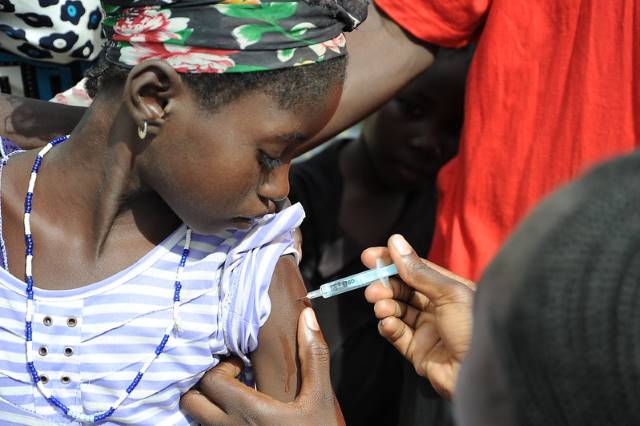7 Facts About the Shot@Life Campaign
 Through the use of public education, grassroots advocacy and fundraising, Shot@Life strives to decrease vaccine-preventable childhood deaths to zero by the year 2030. The Shot@Life campaign has an overall goal for every child to have a shot at life no matter where they live.
Through the use of public education, grassroots advocacy and fundraising, Shot@Life strives to decrease vaccine-preventable childhood deaths to zero by the year 2030. The Shot@Life campaign has an overall goal for every child to have a shot at life no matter where they live.
7 Facts About the Shot@Life Campaign
- The initiative began as a grassroots advocacy campaign. Shot@Life was founded in 2011 as part of the United Nations Foundation that aims to ensure that children around the world have access to lifesaving vaccines. Its programs help raise awareness and funds that contribute to child immunization programs hosted by world health organizations like UNICEF, the World Health Organization (WHO) and Gavi, the Vaccine Alliance. The campaign has amassed thousands of supporters over the years, ranging from members of Congress to local and national businesses.
- Shot@Life recognizes the importance of vaccines for saving children’s lives. Projections indicate that 17.7 million deaths may be averted in children under age five years as a result of vaccinations administered from 2011 to 2020. With medicine continuing to evolve, diseases that have been around for hundreds of years are finally able to be addressed.
- The campaign focuses on four main vaccines. The four vaccine-preventable diseases it centers its attention on are polio, measles, pneumonia and rotavirus. To this day, Afghanistan, Nigeria and Pakistan are still polio-endemic countries. Additionally, the majority of people who contract measles were unvaccinated. Diarrhea, a common consequence of rotavirus, and pneumonia are two of the leading causes of child mortality. Combined, they account for approximately 1.4 million deaths around the world every year.
- Shot@Life achieved a lot during its first five years of operation. Through the program’s support and its advocates, the campaign was able to secure over $2 billion in U.S. funding for global immunization programs between fiscal years 2012 to 2017. From its support of the United Nations’ partner programs between 2012 and 2016, the campaign was also able to provide more than 42 million children around the world with life-saving vaccines. In collaboration with its global partners, Shot@Life was also able to contribute to the 84% drop in global measles deaths from 2000 to 2016, which saved more than 20 million children’s lives. Another accomplishment is the fact that 16 million people who otherwise would have been paralyzed by polio are still walking thanks to the partnership between Shot@Life and the U.N. Foundation’s Global Polio Eradication Initiative.
- It has hosted multiple campaigns with the pharmacy, Walgreens. Walgreens has been one of the key partners of Shot@Life since the beginning of the campaign’s advocacy efforts. Shot@Life partnered with the drugstore chain on the “get a shot, give a shot” campaign, which aims to supply 100 million vaccines by 2024 to children in need around the world. This campaign, which began in 2013, is still in operation to this day. Its most recent campaign with Walgreens began on September 1, 2020, with Walgreens pledging to donate $0.23 per immunization shot a patient receives from a Walgreens pharmacy. The fundraiser runs until December 31, 2020, and is set to raise a maximum of $2.6 million
for Shot@Life. - The campaign runs a blog dedicated to Shot@Life and vaccine-related issues. Part of its educational efforts includes hosting and contributing to the Shot@Life blog. With its first post dating back to 2011, the posts cover a variety of topics about vaccines and success stories related to the campaign. One of its most recent articles broke down COVID-19’s negative impact on refugees and providing them with adequate healthcare, including vaccines.
- Shot@Life outlines a variety of ways to advocate for the campaign. Through its “take action now” page on its website, Shot@Life highlights numerous ways U.S. constituents can put their support behind the campaign and efforts to provide vaccines for children globally. It encourages reaching out to U.S. Senators and Representative’s offices by calling, emailing and writing letters to get Shot@Life on their radar to support. One of its programs, “Shot@Life Champions,” is a way for members of the public to increase their support of the organization. These advocates attend training webinars and events to learn how to further the efforts of the campaign as well as encourage other members in the community to join the cause.
Since its beginning in 2011, Shot@Life has amassed more than 350,000 supporters and 2,000 grassroots advocates in all 50 U.S. states who call on their communities to support the campaign for global vaccines. Through education and advocacy, Shot@Life acknowledges the vital role that providing vaccines for children plays in preventing their deaths, especially in developing nations.
– Sara Holm
Photo: Flickr
